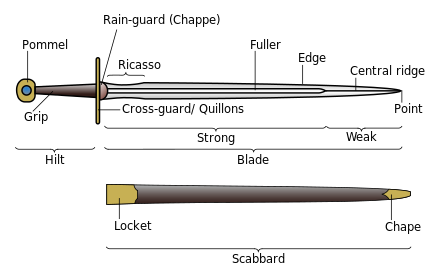Sword

A sword is an edged, bladed weapon intended for manual cutting or thrusting. Its blade, longer than a knife or dagger, is attached to a hilt and can be straight or curved. A thrusting sword tends to have a straighter blade with a pointed tip. A slashing sword is more likely to be curved and to have a sharpened cutting edge on one or both sides of the blade. Many swords are designed for both thrusting and slashing. The precise definition of a sword varies by historical epoch and geographic region.
Historically, the sword developed in the
The use of a sword is known as swordsmanship or, in a modern context, as fencing. In the early modern period, western sword design diverged into two forms, the thrusting swords and the sabres.
Thrusting swords such as the rapier and eventually the smallsword were designed to impale their targets quickly and inflict deep stab wounds. Their long and straight yet light and well balanced design made them highly maneuverable and deadly in a duel but fairly ineffective when used in a slashing or chopping motion. A well aimed lunge and thrust could end a fight in seconds with just the sword's point, leading to the development of a fighting style which closely resembles modern fencing.
Slashing swords such as the sabre and similar blades such as the cutlass were built more heavily and were more typically used in warfare. Built for slashing and chopping at multiple enemies, often from horseback, the sabre's long curved blade and slightly forward weight balance gave it a deadly character all its own on the battlefield. Most sabres also had sharp points and double-edged blades, making them capable of piercing soldier after soldier in a cavalry charge. Sabres continued to see battlefield use until the early 20th century. The US Navy M1917 Cutlass used in World War I, was kept in their armory well into World War II and many Marines were issued a variant called the M1941 Cutlass as a makeshift jungle machete during the Pacific War.[2][3]
Non-European weapons classified as swords include single-edged weapons such as the Middle Eastern scimitar, the Chinese dao and the related Japanese katana. The Chinese jiàn 剑 is an example of a non-European double-edged sword, like the European models derived from the double-edged Iron Age sword.
History
Prehistory and antiquity
Bronze Age
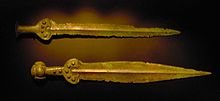
The first weapons that can be described as "swords" date to around 3300 BC. They have been found in
The sword developed from the knife or dagger. The sword became differentiated from the dagger during the Bronze Age (c. 3000 BC), when copper and bronze weapons were produced with long leaf-shaped blades and with hilts consisting of an extension of the blade in handle form. A knife is unlike a dagger in that a knife has only one cutting surface, while a dagger has two cutting surfaces.[6] Construction of longer blades became possible during the 3rd millennium BC in the Middle East, first in arsenic copper, then in tin-bronze.[7]
Blades longer than 60 cm (24 in) were rare and not practical until the late Bronze Age because the
One of the most important, and longest-lasting, types of swords of the
Naue II swords were exported from Europe to the Aegean, and as far afield as
In the
Iron Age

Iron became increasingly common from the 13th century BC. Before that the use of swords was less frequent. The iron was not quench-hardened although often containing sufficient carbon, but work-hardened like bronze by hammering. This made them comparable or only slightly better in terms of strength and hardness to bronze swords. They could still bend during use rather than spring back into shape. But the easier production, and the better availability of the raw material for the first time permitted the equipping of entire armies with metal weapons, though Bronze Age Egyptian armies were sometimes fully equipped with bronze weapons.[19]
Ancient swords are often found at burial sites. The sword was often placed on the right side of the corpse. Many times the sword was kept over the corpse. In many late Iron Age graves, the sword and the scabbard were bent at 180 degrees. It was known as killing the sword. Thus they might have considered swords as the most potent and powerful object.[20]
Indian antiquity
High-carbon steel for swords, which would later appear as
Greco-Roman antiquity
By the time of
Swords from the Parthian and Sassanian Empires were quite long, the blades on some late Sassanian swords being just under a metre long.[27]
Swords were also used to administer various
Persian antiquity
In the first millennium BC, the Persian armies used a sword that was originally of Scythian design called the akinaka (acinaces).[29] However, the great conquests of the Persians made the sword more famous as a Persian weapon, to the extent that the true nature of the weapon has been lost somewhat as the name akinaka has been used to refer to whichever form of sword the Persian army favoured at the time.[30]
It is widely believed that the original akinaka was a 35 to 45 cm (14 to 18 inch) double-edged sword. The design was not uniform and in fact identification is made more on the nature of the scabbard than the weapon itself; the scabbard usually has a large, decorative mount allowing it to be suspended from a belt on the wearer's right side. Because of this, it is assumed that the sword was intended to be drawn with the blade pointing downwards ready for surprise stabbing attacks.
In the 12th century, the
Chinese antiquity
Chinese iron swords made their first appearance in the later part of the
Middle Ages
Europe
Early and High Middle Ages
During the
Around the 10th century, the use of properly quenched hardened and tempered steel started to become much more common than in previous periods. The Frankish 'Ulfberht' blades (the name of the maker inlaid in the blade) were of particularly consistent high quality.[32] Charles the Bald tried to prohibit the export of these swords, as they were used by Vikings in raids against the Franks.
Wootz steel (which is also known as Damascus steel) was a unique and highly prized steel developed on the Indian subcontinent as early as the 5th century BC. Its properties were unique due to the special smelting and reworking of the steel creating networks of iron carbides described as a globular cementite in a matrix of pearlite. The use of Damascus steel in swords became extremely popular in the 16th and 17th centuries.[nb 1][33]
It was only from the 11th century that
It was during the 14th century, with the growing use of more advanced armour, that the hand and a half sword, also known as a "bastard sword", came into being. It had an extended grip that meant it could be used with either one or two hands. Though these swords did not provide a full two-hand grip they allowed their wielders to hold a shield or parrying dagger in their off hand, or to use it as a two-handed sword for a more powerful blow.[35]
In the Middle Ages, the sword was often used as a symbol of the
Late Middle Ages
From around 1300 to 1500, in concert with improved

The estoc became popular because of its ability to thrust into the gaps between plates of armour.[38] The grip was sometimes wrapped in wire or coarse animal hide to provide a better grip and to make it harder to knock a sword out of the user's hand.[39]
A number of manuscripts covering longsword combat and techniques dating from the 13th–16th centuries exist in German,[40] Italian, and English,[41] providing extensive information on longsword combatives as used throughout this period. Many of these are now readily available online.[40][41]
In the 16th century, the large zweihänder was used by the elite German and Swiss mercenaries known as doppelsöldners.[42] Zweihänder, literally translated, means two-hander. The zweihänder possesses a long blade, as well as a huge guard for protection. It is estimated that some zweihänder swords were over 6 feet (1.8 m) long, with the one ascribed to Frisian warrior Pier Gerlofs Donia being 7 feet (2.13 m) long.[43] The gigantic blade length was perfectly designed for manipulating and pushing away enemy polearms, which were major weapons around this time, in both Germany and Eastern Europe. Doppelsöldners also used katzbalgers, which means 'cat-gutter'. The katzbalger's S-shaped guard and 2-foot-long (0.61 m) blade made it perfect for bringing in when the fighting became too close to use a zweihänder.[44]
Civilian use of swords became increasingly common during the late Renaissance, with duels being a preferred way to honourably settle disputes.
The side-sword was a type of war sword used by infantry during the Renaissance of Europe. This sword was a direct descendant of the knightly sword. Quite popular between the 16th and 17th centuries, they were ideal for handling the mix of armoured and unarmoured opponents of that time. A new technique of placing one's finger on the ricasso to improve the grip (a practice that would continue in the rapier) led to the production of hilts with a guard for the finger. This sword design eventually led to the development of the civilian rapier, but it was not replaced by it, and the side-sword continued to be used during the rapier's lifetime. As it could be used for both cutting and thrusting, the term "cut and thrust sword" is sometimes used interchangeably with side-sword.[45] As rapiers became more popular, attempts were made to hybridize the blade, sacrificing the effectiveness found in each unique weapon design. These are still considered side-swords and are sometimes labeled sword rapier or cutting rapier by modern collectors.
Side-swords used in conjunction with bucklers became so popular that it caused the term swashbuckler to be coined. This word stems from the new fighting style of the side-sword and buckler which was filled with much "swashing and making a noise on the buckler".[46]
Within the Ottoman Empire, the use of a curved sabre called the yatagan started in the mid-16th century. It would become the weapon of choice for many in Turkey and the Balkans.[47]
The sword in this time period was the most personal weapon, the most prestigious, and the most versatile for close combat, but it came to decline in military use as technology, such as the
Middle East
The earliest evidence of curved swords, or
Africa

The takoba is a type of broadsword originating in the western Sahel, descended from various Byzantine and Islamic swords. It has a straight double-edged blade measuring about one meter in length, usually imported from Europe.[50][51]
Abyssinian swords related to the Persian shamshir are known as shotel.[52] The Asante people adopted swords under the name of akrafena. They are still used today in ceremonies, such as the Odwira festival.[53][54]
East Asia

As steel technology improved, single-edged weapons became popular throughout Asia. Derived from the Chinese jian or dao, the Korean hwandudaedo are known from the early medieval Three Kingdoms. Production of the Japanese tachi, a precursor to the katana, is recorded from c. AD 900 (see Japanese sword).[55]

Japan was famous for the swords it forged in the early 13th century for the class of warrior-nobility known as the Samurai. Western historians have said that Japanese katana were among the finest cutting weapons in world military history.[56][57][58] The types of swords used by the Samurai included the ōdachi (extra long field sword), tachi (long cavalry sword), katana (long sword), and wakizashi (shorter companion sword for katana). Japanese swords that pre-date the rise of the samurai caste include the tsurugi (straight double-edged blade) and chokutō (straight one-edged blade).[59] Japanese swordmaking reached the height of its development in the 15th and 16th centuries, when samurai increasingly found a need for a sword to use in closer quarters, leading to the creation of the modern katana.[60] High quality Japanese swords have been exported to neighboring Asian countries since before the 11th century. From the 15th century to the 16th century, more than 200,000 swords were exported, reaching a quantitative peak, but these were simple swords made exclusively for mass production, specialized for export and lending to conscripted farmers (ashigaru).[61][62][63]
South Asia
The
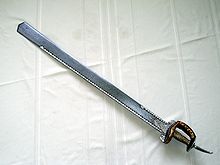
The
The
The urumi (Tamil: சுருள் பட்டாக்கத்தி surul pattai, lit. curling blade; Sinhala: එතුණු කඩුව ethunu kaduwa; Hindi: aara) is a "sword" with a flexible whip-like blade.[70]
Southeast Asia
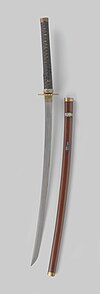
In Indonesia, the images of Indian style swords can be found in Hindu gods statues from ancient Java circa 8th to 10th century. However the native types of blade known as kris, parang, klewang and golok were more popular as weapons. These daggers are shorter than a sword but longer than a common dagger.
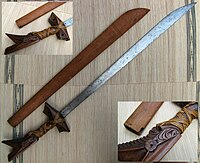
In the
Pre-Columbian Americas
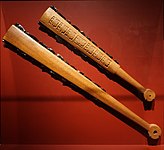
The .
Pacific Islands
In the Gilbert Islands, the native Kiribati people have developed a type of broadsword made from shark teeth, which serves a similar function to the leiomano used by the Native Hawaiians.
Early modern history
Military sword
A single-edged type of
The
Duelling sword

The
During the 17th and 18th centuries, the shorter
As the wearing of swords fell out of fashion,
Late modern history
Military sidearm
Towards the end of its useful life, the sword served more as a weapon of
However, swords were still normally carried in

Swords continued in general peacetime use by cavalry of most armies during the years prior to World War I. The British Army formally adopted a completely new design of
In China troops used the long anti-cavalry
Ceremonial use
Swords are commonly worn as a ceremonial item by officers in many military and naval services throughout the world. Occasions to wear swords include any event in dress uniforms where the rank-and-file carry arms: parades, reviews, courts-martial, tattoos, and changes of command. They are also commonly worn for officers' weddings, and when wearing dress uniforms to church—although they are rarely actually worn in the church itself.
In the British forces they are also worn for any appearance at
In the
The Marine officer swords are of the Mameluke pattern which was adopted in 1825 in recognition of the Marines' key role in the capture of the Tripolitan city of Derna during the First Barbary War.[96] Taken out of issue for approximately 20 years from 1855 until 1875, it was restored to service in the year of the Corps' centennial and has remained in issue since.
Religious
In the occult practices of Wicca, a sword or knife often referred to as an athame is used as a magical tool.[97]
Sword replicas
The production of replicas of historical swords originates with 19th-century historicism.[98] Contemporary replicas can range from cheap factory produced look-alikes to exact recreations of individual artifacts, including an approximation of the historical production methods.
Some kinds of swords are still commonly used today as weapons, often as a side arm for military infantry. The Japanese
- In the case of a rat-tail tang, the maker welds a thin rod to the end of the blade at the crossguard; this rod goes through the grip.[100]
- In traditional construction, Swordsmiths peened such tangs over the end of the pommel, or occasionally welded the hilt furniture to the tang and threaded the end for screwing on a pommel. This style is often referred to as a "narrow" or "hidden" tang. Modern, less traditional, replicas often feature a threaded pommel or a pommel nut which holds the hilt together and allows dismantling.[citation needed]
- In a "full" tang (most commonly used in knives and machetes), the tang has about the same width as the blade, and is generally the same shape as the grip.[101] In European or Asian swords sold today, many advertised "full" tangs may actually involve a forged rat-tail tang.
Morphology
The sword consists of the blade and the hilt. The term scabbard applies to the cover for the sword blade when not in use.
Blade
There is considerable variation in the detailed design of sword blades. The diagram opposite shows a typical Medieval European sword.
Early iron blades have rounded points due to the limited metallurgy of the time. These were still effective for thrusting against lightly armoured opponents. As armour advanced, blades were made narrower, stiffer and sharply pointed to defeat the armour by thrusting.
Dedicated cutting blades are wide and thin, and often have grooves known as
The part of the blade between the
The ricasso or shoulder identifies a short section of blade immediately below the guard that is left completely unsharpened. Many swords have no ricasso. On some large weapons, such as the German Zweihänder, a metal cover surrounded the ricasso, and a swordsman might grip it in one hand to wield the weapon more easily in close-quarter combat.[44] The ricasso normally bears the maker's mark.
The tang is the extension of the blade to which the hilt is fitted.
On Japanese blades, the maker's mark appears on the tang under the grip.[103]
Hilt

The
In late medieval and Renaissance era European swords, a flap of leather called the chappe or rain guard was attached to a sword's crossguard at the base of the hilt to protect the mouth of the scabbard and prevent water from entering.[106]
Sword scabbards and suspension
Common accessories to the sword include the scabbard, baldric as well as the 'sword belt'.
- The scabbard, also known as the sheath, is a protective cover often provided for the sword blade. Over the millennia, scabbards have been made of many materials, including leather, wood, and metals such as brass or steel. The metal fitting where the blade enters the leather or metal scabbard is called the throat, which is often part of a larger scabbard mount, or locket, that bears a carrying ring or stud to facilitate wearing the sword. The blade's point in leather scabbards is usually protected by a metal tip, or chape, which on both leather and metal scabbards is often given further protection from wear by an extension called a drag, or shoe.[107]
- A sword belt is a
Typology
Sword typology is based on morphological criteria on the one hand (blade shape (cross-section, taper, and length), shape and size of the hilt and pommel), and age and place of origin on the other (Bronze Age, Iron Age, European (medieval, early modern, modern), Asian).
The relatively comprehensive
Single vs. double-edged
As noted above, the terms
Jian
In most Asian countries, a sword (jian 劍, geom (검), ken/tsurugi (剣) is a double-edged straight-bladed weapon, while a knife or sabre (dāo 刀, do (도), to/katana (刀) refers to a single-edged object.
Kirpan
Among the Sikhs, the sword is held in very high esteem. A single-edged sword is called a kirpan, and its double-edged counterpart a khanda or tegha.[111]
Churika
The
Backsword and falchion
European terminology does give generic names for single-edged and double-edged blades but refers to specific types with the term 'sword' covering them all. For example, the backsword may be so called because it is single-edged but the falchion which is also single-edged is given its own specific name.[112]
Single vs. two-handed use

Two-handed
A two-handed sword is any sword that usually requires two hands to wield, or more specifically the very large swords of the 16th century.[104]
Throughout history two-handed swords have generally been less common than their one-handed counterparts, one exception being their common use in Japan. Two-handed grips have two advantages: obviously they allow the strength of two hands to be used, not just one, but by spacing the hands apart they also allow a torque to be applied, rotating the sword in a slashing manner.
A two-handed grip may be needed for one of two reasons: either to wield a particularly large sword or else with the single-sided Japanese tachi for a slashing cut. Slashing swords may have distinctively long hilt grips to facilitate this.
Hand and a half sword
A Hand and a half sword, colloquially known as a "
Laws on carrying a sword

The
In fiction
In fantasy, magic swords often appear, based on their use in myth and legend. The science fiction counterpart to these is known as an energy sword (sometimes also referred to as a "beam sword" or "laser sword"), a sword whose blade consists of, or is augmented by, concentrated energy. A well known example of this type of sword is the lightsaber, shown in the Star Wars franchise.[114]
See also
- Arabic swords
- Chinese swords
- Classification of swords
- Japanese swords
- List of blade materials
- List of sword manufacturers
- List of swords
- Oakeshott typology
- Sword making
- Swordsmanship
- Types of swords
- Waster
References
- Footnotes
- ^ "Pattern-Welding and Damascening of Sword-Blades: Part 1 Pattern-Welding" (Maryon 1960)[33]A brief review article by the originator of the term "pattern-welding" accurately details all the salient points of the construction of pattern-welded blades and of how all the patterns observed result as a function of the depth of grinding into a twisted rod structure. The article also includes a brief description of pattern-welding as encountered in the Malay keris. Damascus steel is also known as watered steel.
- Citations
- ^ cognate to Old High German swert, Old Norse sverð, from a Proto-Indo-European root *swer- "to wound, to cut". Before about 1500, the spelling swerd(e) was much more common than sword(e). The irregular loss of /w/ in English pronunciation also dates to about 1500, and is found in a small number of other words, such as answer (cf. swear), conquer (cf. query). Charles Barber, Joan Beal, Philip Shaw, The English Language, Canto Classics, 2nd revised edition, Cambridge University Press, 2012, p. 206 Archived 13 March 2017 at the Wayback Machine.
Latin had epée. Both gladius and spatha are loanwords in Latin; ensis was the generic term for "sword" in Classical Latin, and was again widely used in Renaissance Latin, while Middle Latin mostly used gladius as the generic term.
- ^ Clements, J., & Hertz, B. (n.d.). The Myth of Thrusting versus Cutting Swords. https://www.thearma.org/essays/thrusting_vs_cutting.html
- ^ Wagner, R. (n.d.). Focus on the M1917/M1941 Cutlass. Angelfire. https://www.angelfire.com/wa/swordcollector/cutlass.html
- ^ Frangipane, M. et.al. (2010). "The collapse of the 4th millennium centralised system at Arslantepe and the far-reaching changes in 3rd millennium societies". ORIGINI XXXIV, 2012: 237–60.
- ^ ISBN 978-9004496934. Retrieved 15 January 2024.
- ^ "sword | weapon | Britannica". www.britannica.com. Retrieved 1 May 2022.
- ISBN 978-93-86019-80-6.
- ISBN 978-1-78087-340-4.
- ISBN 978-93-86019-80-6.
- JSTOR 502497.
- ^ PutraDanayu (30 March 2021). Sword: Tell about sword in human history. Putra Ayu.[permanent dead link]
- ^ Jung, R.; M. Mehofer (2008). "A sword of Naue II type from Ugarit and the Historical Significance of Italian type Weaponry in the Eastern Mediterranean", Aegean Archaeology 8, 111–36.
- ]
- S2CID 162347126.
- ^ Bunnefeld, Jan-Heinrich (December 2016). "Crafting Swords. The emergence and production of full-hilted swords in the Early Nordic Bronze Age". Praehistorisches Zeitschrift. 91: 384 – via EBSCO host.
- ISBN 978-0-300-03578-0.
- ^ a b Cao, Hangang. "A Study of Chinese Weapons Cast During Pre-Qin and Han Periods in the Central Plains of China". Archived from the original on 15 May 2011. Retrieved 3 November 2010.
- ^ a b c Allchin, pp. 111–14.
- ^ Burton, p. 78.
- ^ Wells, Peter (2017), How Ancient Europeans Saw the World : Vision, Patterns, and the Shaping of the Mind in Prehistoric Times, Princeton, New Jersey: Princeton UP, p. 124
- S2CID 210305604.
- ^ a b Prasad, chapter IX
- ISBN 978-0-415-09816-8. Archivedfrom the original on 17 May 2016. Retrieved 18 November 2010.
- ISBN 978-0-19-815090-9. Archivedfrom the original on 19 May 2016. Retrieved 18 November 2010.
- ISBN 978-1-84603-386-5. Archivedfrom the original on 8 May 2016. Retrieved 18 November 2010.
- ISBN 978-0-8132-0842-8. Archivedfrom the original on 11 May 2016. Retrieved 18 November 2010.
- ISBN 978-93-86019-80-6.
- ^ Naish, p. 39.
- ISBN 978-1-5267-7275-6.
- ISBN 978-93-86019-80-6.
- ISBN 0-521-54740-7
- ISBN 978-0-511-03025-3. Retrieved 14 November 2010.
Ulfberht.
- ^ JSTOR 1505063.
- ISBN 0-8240-7644-3
- ^ Gravett, p. 47
- ISBN 978-0-486-42523-8.
- ISBN 978-1-84176-988-2.
- ^ Tarassuk, Leonid; Blair, Claude (1982). The Complete Encyclopedia of Arms & Weapons: The Most Comprehensive Reference Work Ever Published on Arms and Armour from Prehistoric Times to the Present – with Over 1,200 Illustrations. Simon & Schuster. p. 491.
- ^ a b McLean, p. 178.
- ^ a b "Transkription von cgm582". Pragmatische Schriftlichkeit. Archived from the original on 9 March 2011. Retrieved 10 November 2010.
- ^ a b "15th Century English Combat Manuscripts". The English Martial Arts Academy. Archived from the original on 27 July 2011. Retrieved 10 November 2010.
- ISBN 3-87748-636-3
- ^ "Greate Pier fan Wûnseradiel" (in Western Frisian). Gemeente Wûnseradiel. Archived from the original on 3 September 2012. Retrieved 4 January 2008.
- ^ ISBN 978-0-85045-258-7.
- ^ The term cut & thrust is a non-historical classification first used within The Association for Renaissance Martial Arts to differentiate cutting swords with compound hilts from true rapiers.
- ^ "Practical Side Sword". Fencing.net. Archived from the original on 31 October 2010. Retrieved 22 November 2010.
- ISBN 978-87-89384-31-3.
- ^ a b "Encyclopædia Britannica-"Sword"". The Encyclopædia Britannica. Archived from the original on 19 April 2010. Retrieved 10 November 2010.
- ISBN 978-0-313-32270-9.
- ^ Jones, Lee A. (15 March 1998). "Takouba - Swords of the Saharan Tuareg". Retrieved 6 July 2019.
- ^ "What is a takouba?". Takouba Research Society. Archived from the original on 7 August 2020. Retrieved 6 July 2019.
- Royal United Service Institution (1869). Journal of the Royal United Service Institution. Vol. 12. Mitchell. p. 515.
- ISBN 9781870345590.
- Trustees of the British Museum. Retrieved 10 April 2019.
- ISBN 0-415-32962-0
- ISBN 978-1-84908-658-5. Archivedfrom the original on 29 April 2016.
- ISBN 978-0-7566-2210-7.
- ^ Bryant, Anthony J.; Angus McBride. Samurai 1550–1600, p. 49.
- ISBN 4-7700-2071-6
- ISBN 978-4-7700-2071-0. Archivedfrom the original on 3 June 2016. Retrieved 18 November 2010.
- ^ 日本の技術の精巧さは.... Mainichi Shimbun. 27 March 2016
- ISBN 978-4062920933
- ^ 歴史人 September 2020, p. 40. ASIN B08DGRWN98
- ^ Murty, M. L. K. (2003), p. 91.
- ISBN 978-1-58340-469-0.
- ^ Freese, Brett Leslie. "Wind-Powered Furnaces". archaeology.org. Archived from the original on 19 June 2011. Retrieved 6 November 2010.
- ^ Stone and LaRocca, p. 229.
- ^ Evangelista, p. 575.
- ISSN 0277-3066.
- ^ Saravanan, T. (2005). "Valorous Sports Metro Plus Madurai". The Hindu. Archived from the original on 22 October 2012.
- ^ "Kampilan". Malay World Edged Weapons. old.blades.free.fr. 13 March 2007. Archived from the original on 31 December 2009. Retrieved 5 February 2009.
- ^ Guro, Tony (4 May 2012). "Traditional Filipino Weapons". Philippine Martial Arts Institute. Archived from the original on 29 May 2012. Retrieved 4 May 2012.
- ^ Rousseau, Robert; About.com Guide (4 May 2012). "A History and Style Guide of Kali". About.com. Archived from the original on 1 February 2012. Retrieved 4 May 2012.
- ^ In 1579, Styria records delivery of some 700 Dusäggen by local bladesmiths, besides payment of 40 Dusäggen delivered from Passau, as part of the preparation for the war against the Turks under Archduke Charles II. "Säbel, 'Dusägge', Deutsch Ende 16. Jahrhundert" Archived 3 March 2016 at the Wayback Machine, Waffensammlung Beck, Inv-Nr.:Be 10.
- ^ Claude Blair, "The Early Basket Hilt in Britain" in: Scottish Weapons and Fortifications (ed. David H. Caldwell, 1981)
- ].
- ^ Grandy, Bill. "Pappenheimer Sword". Archived from the original on 2 November 2016. Retrieved 30 December 2016.
- ^ UK., The Fitzwilliam Museum, University of Cambridge (1 January 2012). "Collections Explorer – Object Detail (HEN.M.219-1933, id:1)". Archived from the original on 2 April 2012. Retrieved 30 December 2016.
{{cite web}}: CS1 maint: multiple names: authors list (link) - ^ Robinson, Nathan. "Walloon Swords". Archived from the original on 29 June 2017. Retrieved 30 December 2016.
- ^ "Statens försvarshistoriska museer". Archived from the original on 4 January 2017. Retrieved 30 December 2016.
- ^ Kirkland p. 17
- ^ Green pp. 583–84
- ^ Wikidata Q105271484.
- ISBN 0-405-13089-9
- ^ pbs.org Archived 22 April 2006 at the Wayback Machine
- ^ The last known French duel of public note fought with epées took place in 1967, when Gaston Defferre insulted René Ribière at the French Parliament and was subsequently challenged to a duel fought with swords. René Ribière lost the duel, being wounded twice."People: Apr. 28, 1967". Time. 28 April 1967. Archived from the original on 29 June 2011. Retrieved 30 May 2010.
- ISBN 978-90-04-08834-4.
- ISBN 978-0-275-93965-6.
- ISBN 978-0-09-081201-1.
- ^ Tuchman, Barbara W. (1962). The Guns of August, p. 229. Constable and Co. Ltd.
- ISBN 978-3-902526-86-1.
- ISBN 978-0-7643-2432-1.
- ISBN 978-0-85045-118-4. Archivedfrom the original on 13 May 2016. Retrieved 18 November 2010.
- ISBN 978-1-56239-804-0. Archivedfrom the original on 3 May 2016. Retrieved 18 November 2010.
- ISBN 1-84176-353-5.
- ISBN 978-0-85045-115-3.
- ISBN 978-0-941404-12-9.
- ISBN 978-0-444-51667-1.
- ISBN 978-1-85532-357-5.
- ^ "All About Knife Tangs". Knife Depot. Retrieved 2 December 2018.
- ^ "Tang Types of a Sword". gungfu.com. Archived from the original on 30 October 2006. Retrieved 7 November 2010.
- ^ Geißler, Robert (2014). "Concerning the Sharpness of Blades". HROARR. Archived from the original on 21 May 2014. Retrieved 18 May 2014.
- ISBN 978-0-8048-0509-4.
- ^ ISBN 978-1-84884-133-8.
- ISBN 0-486-43392-7
- ^ Burton, p. 124
- ISBN 0-901721-33-6
- ^ Smith, pp. 133–34
- ^ Uniform dress and appearance regulations for the Royal Air Force (PDF) (Report) (6 ed.). Ministry of Defence. 2004. pp. 9–16 - Ceremonial Sword Belt. AP 1358.
- ^ "39. ROYAL NAVY OFFICERS AND RATINGS, Annex 39A: RN Dress Tables". Royal Navy Book of Reference (PDF) (Report) (9 ed.). October 2018. p. 39A-1,39A-33. BRd3(1).
- ISBN 81-7601-491-5
- ^ Oakeshott, Ewart (1980). European Weapons and Armour. Guildford & London: Lutterworth Press. p. 152.
- ^ ISBN 9781442604971.
- ^ Sophie Borland (21 January 2008). "Lightsabre wins the battle of movie weapons". The Daily Telegraph. Archived from the original on 12 January 2022. Retrieved 26 January 2008.
- Bibliography
- Allchin, F. R. in South Asian Archaeology 1975: Papers from The Third International Conference of The Association of South Asian Archaeologists in Western Europe, Held in Paris (December 1979), edited by J. E. van Lohuizen-de Leeuw. Brill Academic Publishers, Incorporated. 106–18. ISBN 90-04-05996-2.
- Burton, Richard F. (2008).The Book of The Sword. Cosimo, Inc. ISBN 1-60520-436-6.
- Comnena, Anna. (1928). The Alexiad. Ed. and trans. Elizabeth A. Dawes. London: Routledge. Available at the Internet History Sourcebook Archived 6 November 2014 at the Wayback Machine
- Edgerton; et al. (2002). Indian and Oriental Arms and Armour. Courier Dover Publications. ISBN 0-486-42229-1.
- Evangelista, Nick (1995). The Encyclopedia of the Sword. Greenwood Publishing Group. ISBN 978-0-313-27896-9.
- Gravett, Christopher (1997). German Medieval Armies 1000-1300. Osprey Publishing. ISBN 978-1-85532-657-6.
- Green, Thomas A. (2001). Martial Arts of The World: An Encyclopedia. V. 1. ABC-CLIO. ISBN 1-57607-150-2.
- Kirkland, J. Michael (2006). Stage Combat Resource Materials: A Selected and Annotated Bibliography. Greenwood Publishing Group. ISBN 0-313-30710-5.
- McLean, Will; Forgeng, Jeffrey L. (2008). Daily life in Chaucer's England. ABC-CLIO. ISBN 978-0-313-35951-4.
- Naish, Camille (1991). Death Comes to The Maiden: Sex and Execution, 1431–1933. Taylor & Francis Publishing. ISBN 0-415-05585-7.
- Prasad, Prakash Chandra (2003). Foreign Trade and Commerce in Ancient India. Abhinav Publications. ISBN 81-7017-053-2.
- Smith, William (1843). A dictionary of Greek and Roman antiquities. Michigan University Press.
- ISBN 0-300-02425-8.
- Withers, Harvey J. S. (2006). World Swords 1400–1945. Studio Jupiter Military Publishing . ISBN 0-9545910-1-1.




